Many buyers fear customs delays and unexpected duties. I see this often in rubber projects. The root cause is wrong HS codes. The fix is a clear classification map.
The HS code for rubber products sits in Chapter 40. Raw rubbers use 4001–4006. Semi-finished and finished articles use 4007–4017. Common B2B parts: gaskets 4016.93, hoses 4009.xx, belts 4010.xx, wheels/tires 4012.xx.
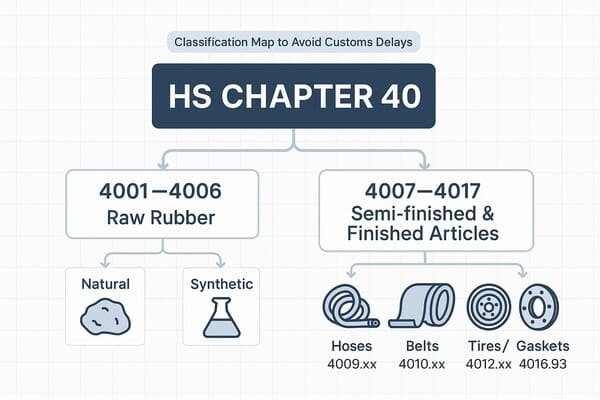
I will break down the logic by product type. I will show quick tables and simple checks that I use in my factory. You can copy this into your RFQ and PO notes.
Which HS chapter covers rubber and rubber products?
Wrong chapter means wrong duty rate. I keep it simple for teams and claim time back at customs.
Rubber and articles of rubber fall under HS Chapter 40. Headings 4001–4006 cover raw and unvulcanized forms. Headings 4007–4017 cover vulcanized articles, belts, tires, tubes, apparel, and “other” rubber goods.
How Chapter 40 is organized
I use a two-lane rule in my daily work. Lane A is raw or unvulcanized. Lane B is vulcanized or finished.
Lane A: Raw/unvulcanized (4001–4006)
- 4001: Natural rubber and similar gums1
- 4002: Synthetic rubber and factice2
- 4003: Reclaimed rubber3
- 4004: Waste and scrap4
- 4005: Compounded rubber, primary forms5 or plates/sheets/strip
- 4006: Other unvulcanized forms, plates/sheets/strip
Lane B: Vulcanized/finished (4007–4017)
- 4007: Vulcanized thread and cord6
- 4008: Vulcanized plates, sheets, rods7, profile shapes
- 4009: Tubes, pipes, hoses
- 4010: Conveyor or transmission belts8
- 4011: New pneumatic tires9
- 4012: Retreaded/used tires10; solid/cushion tires; flaps
- 4013: Inner tubes11
- 4014–4015: Hygienic articles and apparel12
- 4016: Other articles of vulcanized rubber13, other than hard rubber
- 4017: Hard rubber and articles14
Quick reference table
| Lane | Heading Range | Typical Goods | Notes |
|---|---|---|---|
| A | 4001–4006 | Raw, compounded, unvulcanized | No finished article function |
| B | 4007–4017 | Vulcanized articles | Classify by function and build |
✅ This split saves time. I teach new buyers to start with the “state” of rubber, then filter by function.
What HS codes15 apply to common rubber seals and gaskets?
Seals look simple. Customs does not agree. Shape, cut method, and function all matter.
Most rubber seals and gaskets fall under 4016.93 (gaskets, washers, seals). If a part is a simple strip/profile, check 4008. If it is a hose-like part, check 4009.
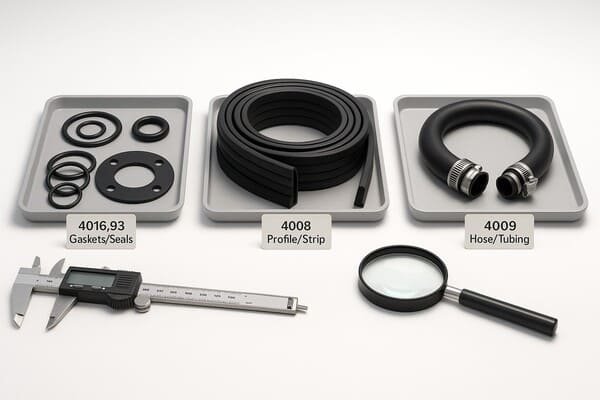
My decision path for seals and gaskets
I ask three quick questions on every drawing:
- Is the part vulcanized and not a hose?
- Does it function as a gasket, washer, or seal?
- Is it not hard rubber (ebonite)?
If “yes” to 1 and 2, and “no” to 3, I start at 4016.93.
Typical codes for sealing parts
| Product Type | HS 6-digit | When I use it | Notes |
|---|---|---|---|
| O-rings, flat gaskets, washers (vulcanized) | 4016.93 | Sealing function is primary | Most HVAC and machinery seals |
| Rubber profiles, rods, strips (vulcanized) | 4008.11–4008.21 | Non-cellular vs cellular; by form | If sold as strip/profile, not as a finished gasket |
| Hard rubber articles | 4017.00 | Ebonite or hard rubber | Different duty in some markets |
| Articles n.e.s. | 4016.99 | When not a gasket/tire/belt etc. | Use carefully; document function |
Field notes from my factory
I ask customers to mark the drawing with the word “gasket” or “seal” and the standard (e.g., DIN ISO 3302-1 M2). I also keep material sheets and test reports ready. This lowers questions at customs and speeds cargo release. I once avoided a 48-hour inspection hold because we added a clear “Function: gasket” note on the packing list. Small step, big effect.
How do I classify rubber hoses and tubes correctly?
Hoses can jump headings if we ignore reinforcement or end fittings. I never guess. I check build.
Rubber hoses and tubes are in 4009. Subheadings depend on reinforcement (textile, metal), rigidity, and if they have fittings. Use 4009.11–4009.99 with care.
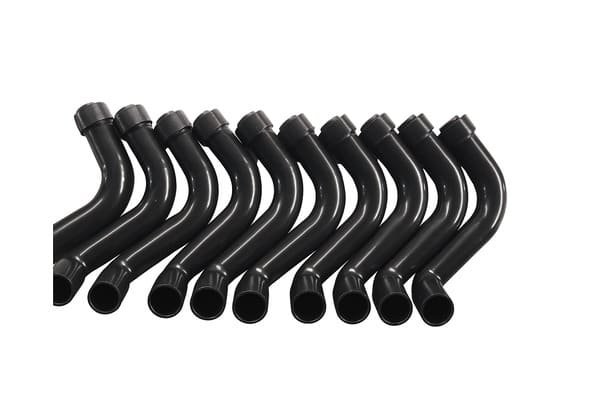
What I check before I pick a hose code
- Is the hose reinforced? With textile? With metal?
- Is it rigid or flexible?
- Does it have fittings attached?
- What is the inner diameter and pressure class?
Common hose subheadings (examples)
| Hose Type | HS 6-digit | Description |
|---|---|---|
| 4009.11 | 4009.11 | Without fittings, reinforced with metal |
| 4009.12 | 4009.12 | Without fittings, reinforced with textile materials |
| 4009.21 | 4009.21 | With fittings, reinforced with metal |
| 4009.22 | 4009.22 | With fittings, reinforced with textile |
| 4009.31/4009.32 | 4009.31/32 | Other hoses, with or without fittings |
Tip: Subheading splits vary by tariff schedule version. I put the build spec on invoices: “EPDM hose, textile braid, no fittings.” This text keeps the code consistent across brokers.
Why drawings and photos help
I add two photos in the file: a cross-section photo and a full-length shot with a ruler. I attach a one-page spec (material, reinforcement, wall, ID/OD, working pressure). Brokers stop asking follow-ups when they see this. My average clearance time drops.
What about rubber wheels and tires for carts and trolleys?
Wheels confuse teams because many look like tires but are solid. Duty rates change by type.
Pneumatic tires use 4011/4012/4013. Solid and cushion tires, and interchangeable treads/ flaps use 4012. Rubber wheels that are not tires often go to 4016.99 or to a heading of the assembled equipment.
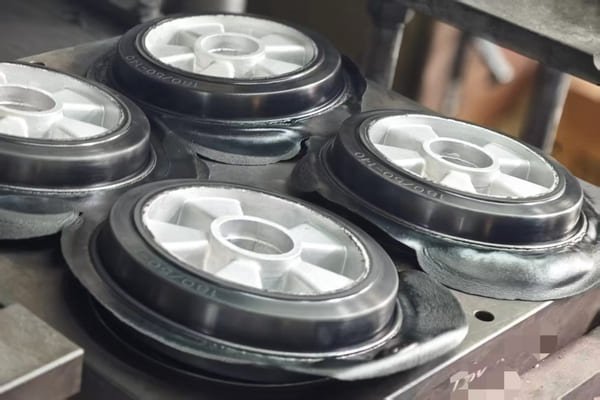
Fast map for wheels and tires
| Product | Likely HS 6-digit | Notes |
|---|---|---|
| New pneumatic tires9 | 4011.xx | By vehicle/application |
| Retreaded/used pneumatic | 4012.11–4012.19 | Check vehicle type |
| Solid/cushion tires | 4012.90 | Common for industrial carts |
| Inner tubes11 | 4013.xx | By vehicle/application |
| Rubber wheel (not a tire) | 4016.99 | If not covered elsewhere |
In my catalog, we produce rubber wheels with aluminum cores. These are often “articles of vulcanized rubber, other than hard rubber” when the assembly is not a tire. I add material split (rubber-to-metal bond) and intended use. When buyers declare “industrial wheel for floor scrubber,” customs understands the use and stops reclassifying it as a tire.
A quick caution on mixed assemblies
If the wheel is a part of a machine delivered assembled, the classification may follow the machine. I align with the importer’s broker early, since this prevents code switches at the port.
What is the HS codes for silicone rubber parts?
Silicone parts often sit at the border of plastics and rubber in the tariff. Teams get stuck and lose days.
Most finished silicone rubber articles classify in Chapter 40, mirroring other vulcanized rubber goods (e.g., 4016.93 for seals). Raw silicones in primary forms use 3910. Kitchenware may fall in 3924 despite silicone material.
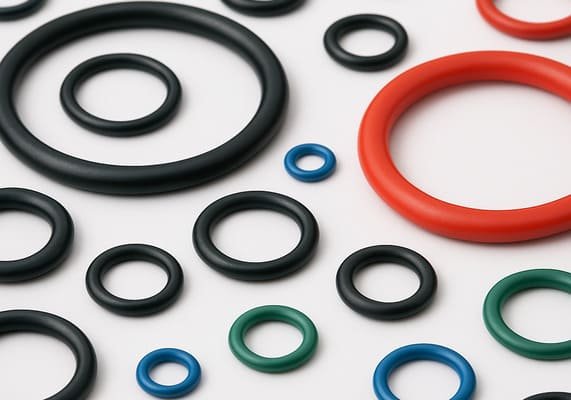
Silicone lives in both worlds. I choose a path based on form and function. I write the material as “VMQ (silicone rubber)” on drawings and invoices. I add cure state and intended use, so customs does not redirect the code.
Where silicone fits in the HS structure
- Raw silicone (LSR/HTV in primary forms): 3910.00 (Silicones in primary forms)
- Unvulcanized sheets/strips, compounded rubber: local rulings vary between 3910 and 4006/4005; I confirm with brokers and provide composition notes
- Vulcanized silicone articles: Chapter 40 subheadings by function (4008/4009/4010/4016, etc.)
- Hygienic/pharma articles: 4014 may apply (e.g., baby bottle teats, similar)
- Kitchenware/tableware: many markets classify in 3924 as household plasticware, even when material is silicone elastomer
My working map for silicone components (production examples)
| Silicone Item | Typical HS 6-digit | Why I choose it | What I add to the invoice |
|---|---|---|---|
| O-rings, gaskets, seals (VMQ) | 4016.93 | Primary sealing function; vulcanized | “Silicone (VMQ) vulcanized gasket, DIN ISO 3302-1 M2” |
| Tubes/hoses (VMQ) | 4009.xx | Rubber hose logic; check reinforcement and fittings | “Silicone hose, textile braid, no fittings” |
| Solid silicone sheets, plates (vulcanized) | 4008.11/19/21 | Vulcanized plates/sheets (cellular vs non-cellular) | “Silicone rubber sheet, non-cellular, vulcanized” |
| Hygienic/pharma nipples/teats | 4014.xx | Listed examples in heading text | “Silicone feeding teat, vulcanized” |
| Kitchenware/bakeware (molds, spatulas) | 3924.xx | Table/kitchen articles of plastics in many rulings | “Silicone bakeware, household article” |
| Raw LSR/HTV compound | 3910.00 | Silicones in primary forms | “Liquid silicone rubber (LSR), platinum-curable, primary form” |
I avoid confusion by stating cure state (vulcanized or not), function, and material family (VMQ) on every document. When the tariff splits by reinforcement or fittings (hoses), I show that with photos.
Practical rules that keep me out of trouble
- I treat finished silicone seals the same as other rubber seals: start with 4016.93 and prove function.
- For silicone hoses, I apply the 4009 decision tree and never omit the reinforcement detail.
- I keep a separate memo for household silicone items. Many customs houses default to 3924 even if the material is elastomeric. I align early with the importer’s broker.
- If a part could be read as “profile/strip” vs “gasket”, I show the operation (die-cut, spliced ring, molded) and the intended sealing use. This pulls it away from 4008 when needed.
Risk hot spots and how I document them (≥200 words)
I see most disputes in three hot spots: (1) raw vs vulcanized state, (2) hose reinforcement, and (3) consumer-use articles. I tackle each with documents.
Raw vs vulcanized: For silicone, the line between 3910 and Chapter 40 matters. If I ship LSR/HTV to a partner, I label drums or pails with “Silicones in primary forms (LSR), uncured.” I attach a formulation sheet without proprietary ratios but with enough descriptors to fit 3910. If I ship unvulcanized sheets/strips, I email the broker first with photos and a short note on intended use. Some ports lean to 4006/4005 for compounded rubber in strip form; others stay with 3910 for silicone-based mixes. My pre-alert avoids holds.
Hose reinforcement: A silicone hose that looks smooth may still contain textile braid. If I fail to state reinforcement, brokers guess. Guesses trigger reclassification from 4009.12 to 4009.22 or vice versa. I print “textile-reinforced” on the invoice, add a cut cross-section photo with a ruler, and note “no fittings” if true. This usually settles the subheading on first pass.
Consumer articles16: Silicone bakeware creates the biggest gap between expectation and reality. Many buyers think “rubber means Chapter 40.” In practice, household silicone tools ride with plastics under 3924. I address this by splitting B2B industrial seals from B2C household goods at the quoting stage. I also add a one-line legal heading text beneath the HS code on our invoice. This single sentence often ends the debate at customs.
How do different markets handle HS codes (US/EU/China)?
I sell to the EU and the US every week. The 6-digit HS base stays the same. The last digits change.
Use the 6-digit HS for universal language. Then map to national schedules: US HTS (10 digits), EU CN (8 digits), and China (10 digits). Duty rates and sub-splits differ by market and year.
Mapping example for a gasket
- Base HS (global): 4016.93
- EU CN (example): 4016 93 00
- US HTS (example): 4016.93.5050
- China Export (example): 4016.93.0000
I keep a small mapping sheet in every sales job folder. I store broker notes by market. I add the code and the legal text on the commercial invoice. My dispute rate is near zero.
Differences you should track
| Item | EU (CN) | US (HTS) | China (Export) |
|---|---|---|---|
| Digits | 8 | 10 | 10 |
| Duty rate | By TARIC | By HTS and MFN | By China export rules |
| Updates | Annually | Annually | Annually |
✅ I review codes every January with our logistics partner. I make updates before the first shipment of the year. This keeps our landed cost model clean.
What documents and tests support HS classification for rubber parts?
Customs wants facts. I give them neat files. My team spends less time on calls.
Provide drawings, material sheets, cure state, build notes, and photos. Add test reports if the code depends on material or performance (e.g., composition, reinforcement, hardness). Include a one-line functional description on the invoice.
My standard support pack
- Engineering drawing with material and tolerance (e.g., EPDM 70 ShA, DIN ISO 3302-1 M2)
- Cure state: vulcanized vs unvulcanized
- Build: reinforcement, fittings, composite structure
- Function line: “Gasket for HVAC duct damper”
- Photos: cross-section and full view with scale
- Material and test reports: hardness, density, tensile, compression set, and any requested compliance
Example: HVAC gasket (EPDM)
- Likely HS: 4016.93
- Key proofs: vulcanized state, sealing function, material sheet
- Risk points: declared as strip (4008) by mistake; avoid by stating “finished gasket” on docs
Example: Textile-reinforced EPDM hose
- Likely HS: 4009.12/4009.22 (depending on fittings)
- Key proofs: reinforcement spec, presence of fittings
- Risk points: broker assumes metal reinforcement; avoid with photo and spec line
Personal note: I once cleared a 2×40' shipment during peak season with zero queries because our invoices had crystal-clear function lines and HS text. The broker sent me a smile emoji. That day felt good.
Quick cheat sheet (copy/paste)
| Category | Typical HS 6-digit | What to write on invoice |
|---|---|---|
| Gaskets, washers, seals | 4016.93 | “Vulcanized rubber gasket, sealing function” |
| Rubber hoses | 4009.xx | “EPDM hose, textile reinforced, no fittings (or with fittings)” |
| Conveyor belts | 4010.xx | “Rubber conveyor belt, ply details” |
| Pneumatic tires | 4011.xx | “New pneumatic tire, application” |
| Solid/cushion tires | 4012.90 | “Solid rubber tire for industrial cart” |
| Inner tubes | 4013.xx | “Rubber inner tube” |
| Other rubber articles | 4016.99 | “Article of vulcanized rubber, function explained” |
| Hard rubber articles | 4017.00 | “Hard rubber (ebonite) article” |
| Silicone (VMQ) gaskets/seals | 4016.93 | “Silicone (VMQ) vulcanized gasket, DIN ISO 3302-1 M2” |
| Silicone (VMQ) hoses/tubes | 4009.xx | “Silicone hose, textile-reinforced, no fittings (or with fittings)” |
| Silicone sheets/plates (vulcanized) | 4008.11/19/21 | “Silicone rubber sheet, non-cellular/cellular, vulcanized” |
| Silicone hygienic teats/nipples | 4014.xx | “Silicone feeding teat, vulcanized” |
| Silicone kitchenware/tableware | 3924.xx | “Silicone bakeware, household article” |
| Silicone in primary forms (LSR/HTV) | 3910.00 | “Liquid silicone rubber (LSR), primary form, uncured” |
Conclusion
Chapter 40 is simple when you follow state, function, and build. Use the 6-digit base, then map locally. Put proofs on paper. Customs will move fast.
Need help with HS codes for your rubber parts?
- Email: info@rubberandseal.com
- Website: www.rubberandseal.com
- We are Julong Rubber. We are a factory in China. We supply custom rubber seals, hoses, gaskets, wheels, and molded parts.
-
Explore this resource to understand the unique characteristics and applications of natural rubber. ↩
-
Learn about synthetic rubber's versatility and its role in various industries. ↩
-
Discover the environmental and economic advantages of reclaimed rubber. ↩
-
Find out how waste rubber can be transformed into valuable materials. ↩
-
Understand the significance of compounded rubber in various manufacturing processes. ↩
-
Explore the applications of vulcanized thread and cord in different industries. ↩
-
Learn how vulcanized materials are utilized in construction and manufacturing. ↩
-
Discover the various types of conveyor belts and their applications in industries. ↩
-
Get insights into the specifications and standards for new pneumatic tires. ↩ ↩
-
Understand the retreading process and its advantages for sustainability. ↩
-
Explore the various types of inner tubes and their uses in vehicles. ↩ ↩
-
Learn about the standards and regulations for rubber hygienic products. ↩
-
Discover the diverse range of products made from vulcanized rubber. ↩
-
Understand the properties and applications of hard rubber in various fields. ↩
-
Learn about the importance of HS codes in global trade and customs. ↩
-
Understand the complexities involved in classifying consumer rubber articles. ↩








